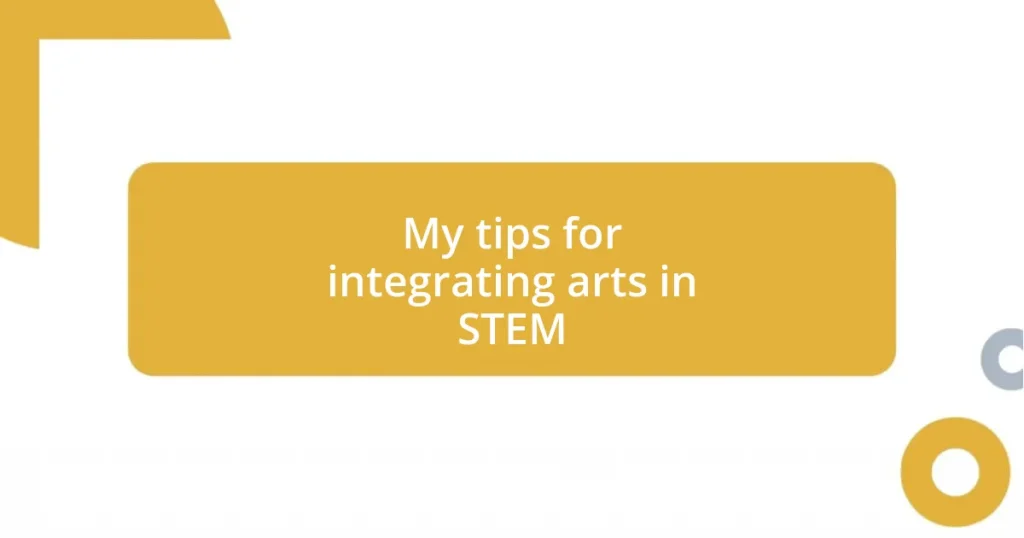Key takeaways:
- STEM education fosters critical thinking, innovation, and adaptability, essential for addressing real-world challenges.
- The integration of arts into STEM (STEAM) enhances creativity, emotional connection, and collaborative problem-solving among students.
- Practical strategies like project-based learning and technology use effectively engage students and deepen their understanding of concepts.
- Measuring the impact of arts integration includes assessing student engagement, problem-solving skills, and knowledge retention, showcasing its positive effects on learning.

Understanding STEM Education Importance
STEM education plays a crucial role in shaping modern society, bridging gaps between disciplines and fostering critical thinking. I remember when I first engaged with a STEM project in high school; the excitement of creating something tangible from an abstract idea was incredibly rewarding. It’s moments like these that ignite a passion for problem-solving, reflecting how essential STEM is in our daily lives.
The integration of STEM not only promotes innovation but also cultivates adaptability, which is increasingly vital in today’s fast-paced world. Have you ever considered how many of our daily conveniences are the result of STEM advancements? I often find myself marveling at how technology has transformed ordinary tasks, reminding me of the endless possibilities that a strong foundation in STEM provides.
Moreover, STEM education equips students with tools to address real-world challenges. When I volunteered in a community project focused on sustainable practices, I witnessed firsthand how young minds could devise creative solutions to environmental issues. Isn’t it inspiring to think about how nurturing these skills can lead to meaningful change in our communities?

Defining Arts Integration in STEM
Integrating the arts into STEM creates a dynamic approach known as STEAM (Science, Technology, Engineering, Arts, and Mathematics). I’ve seen how this blend enriches learning experiences, allowing students to express creativity while engaging with complex subjects. For instance, during a recent workshop, I watched students turn a physics lesson into a vibrant theatrical piece, demonstrating their understanding of energy concepts through movement and performance. It was a vivid reminder that when art meets science, the learning process becomes multifaceted and engaging.
Here are some key aspects of arts integration in STEM:
– Encourages creativity and innovative thinking.
– Promotes emotional connection and personal expression.
– Enhances problem-solving skills through imaginative solutions.
– Bridges the gap between analytical and creative modes of thinking.
– Fosters collaboration among students from diverse disciplines.
Integrating the arts fundamentally shifts the educational narrative, transforming how students perceive and interact with both fields.

Practical Strategies for Arts Integration
Integrating arts into STEM requires practical strategies that not only make learning enjoyable but also deepen understanding. One effective method I’ve found is project-based learning. For example, I once guided a group of students on a project where they designed a bridge using both engineering principles and artistic design elements. Watching them collaborate and blend function with aesthetics was a powerful experience, illustrating how creativity can elevate technical skill.
Another strategy involves using technology to facilitate artistic expression in STEM subjects. I recall a time when we employed graphic design software to create visual representations of scientific data. The students were amazed at how their artistic choices influenced the perception of information. This dual engagement helped them to understand that data isn’t just numbers; it tells a story, reflecting the real-world dynamics behind the statistics.
I also believe that fostering an environment of exploration and curiosity is crucial. Encouraging students to take risks with their ideas can lead to unexpected breakthroughs. For instance, during a science fair, I observed a student combine traditional painting with coding, resulting in an interactive art piece. That moment reinforced my belief that when we allow freedom within our curriculum, creativity blossoms and connects students meaningfully with their learning.
| Strategy | Description |
|---|---|
| Project-Based Learning | Incorporate hands-on projects that fuse arts with STEM concepts to enhance engagement and understanding. |
| Technology Use | Utilize software tools to express STEM data artistically, helping students visualize real-world implications. |
| Cultivating Curiosity | Foster a learning environment that encourages risk-taking and creativity to facilitate organic learning experiences. |

Examples of Successful Arts Integration
In a fascinating initiative at a local school, students combined robotics with dance. I remember feeling moved as they programmed robots to perform choreographed movements synchronized with music. It was thrilling to see how they transformed what many consider rigid technology into an expressive art form. This project not only showcased their technical skills but also highlighted the beauty of collaboration, as the students learned to integrate their creative ideas with engineering principles.
During another project, I found myself swept up in the excitement of students using 3D modeling software to create sculptures that illustrated geometric concepts. Seeing their faces light up as they transitioned from digital designs to physical objects was a testament to the power of blending visual arts with mathematics. Who knew that understanding angles and symmetry could feel so rewarding? This experience reinforced for me that when students can visualize their ideas, they become more invested in their learning journey.
One particularly memorable example occurred during a community event, where students showcased their environmental science projects through art installations. I was struck by a display made from recycled materials, representing the local ecosystem. The creativity and thoughtfulness poured into this work left me pondering, how often do we encourage young minds to explore complex issues like sustainability through artistic lenses? It reminded me that when we integrate arts into STEM learning, we’re not just teaching concepts; we’re nurturing passionate thinkers who can tackle real-world challenges innovatively.

Measuring the Impact of Integration
Measuring the impact of arts integration in STEM education can often feel like navigating uncharted waters, but there are imaginative ways to evaluate its effectiveness. For instance, I’ve observed significant shifts in student engagement through surveys and reflections post-project. When I asked students to express what they enjoyed most about a collaborative art and science project, their enthusiasm was palpable; many mentioned feeling like their ideas truly mattered. It’s these authentic responses that often provide the clearest measures of success.
Another powerful method I’ve utilized is observing changes in students’ problem-solving skills. In one instance, I watched a group tackle an engineering challenge that involved redesigning a funnel for a science experiment. Their artistic approach—crafting a prototype from clay—allowed them to iterate on their design rapidly. The transformation from concept to tangible creation not only showcased their engineering prowess but also highlighted their iterative thinking. How often do we see students embrace failure as a step toward success? This shift is what I believe truly reflects the integration’s positive impact.
Lastly, I’ve found that assessing the retention of knowledge also plays a crucial role in understanding arts integration’s effects. In one memorable class, I led a project where students created comic strips illustrating the principles of physics. When we revisited the topics months later, their ability to explain concepts was impressive, often referencing their comic creations. It’s moments like these that leave me wondering: isn’t it fantastic when learning sticks through creativity? Ultimately, these assessments reveal valuable insights into how integration is shaping not just academic outcomes, but also the emotional and creative growth of students.















